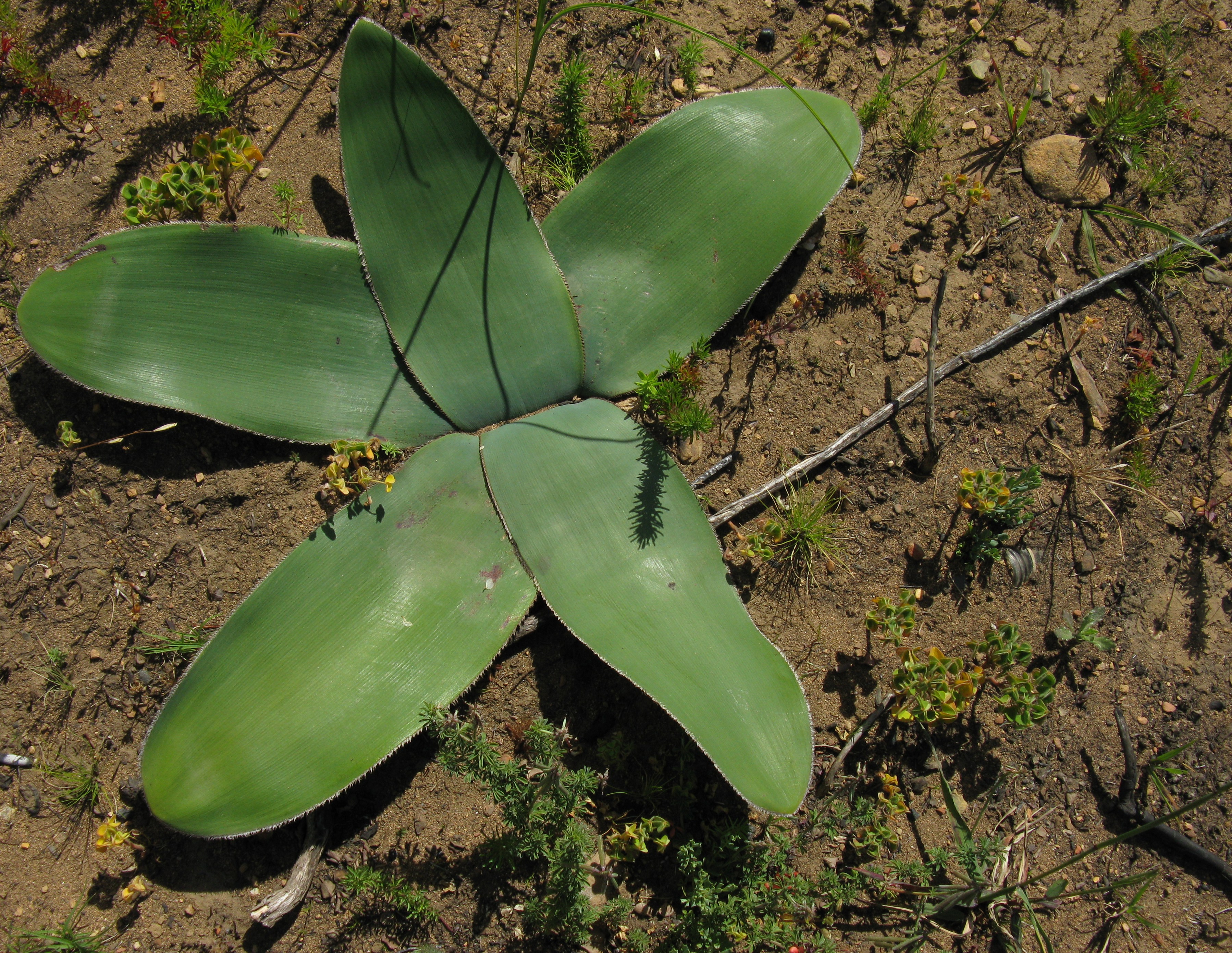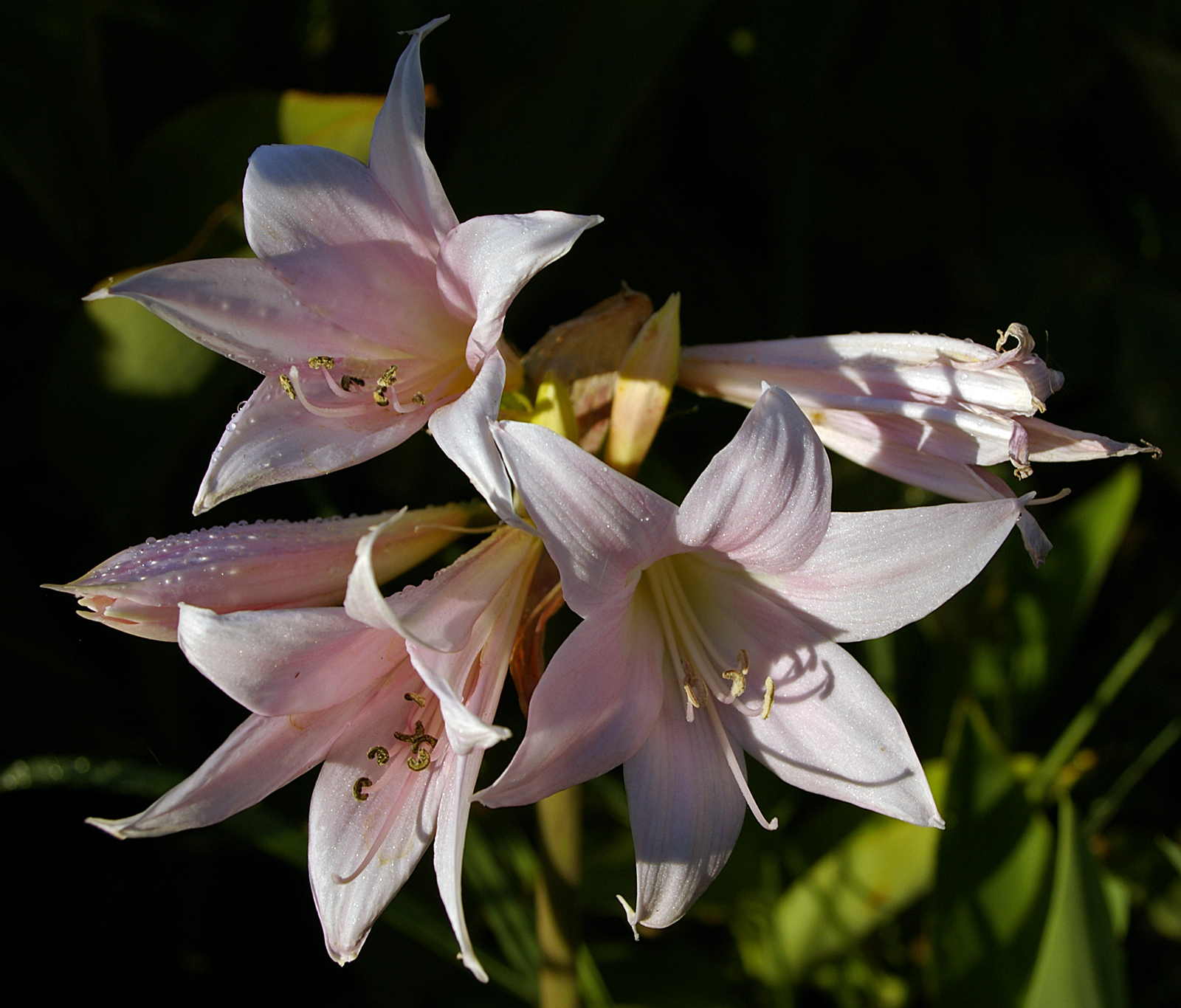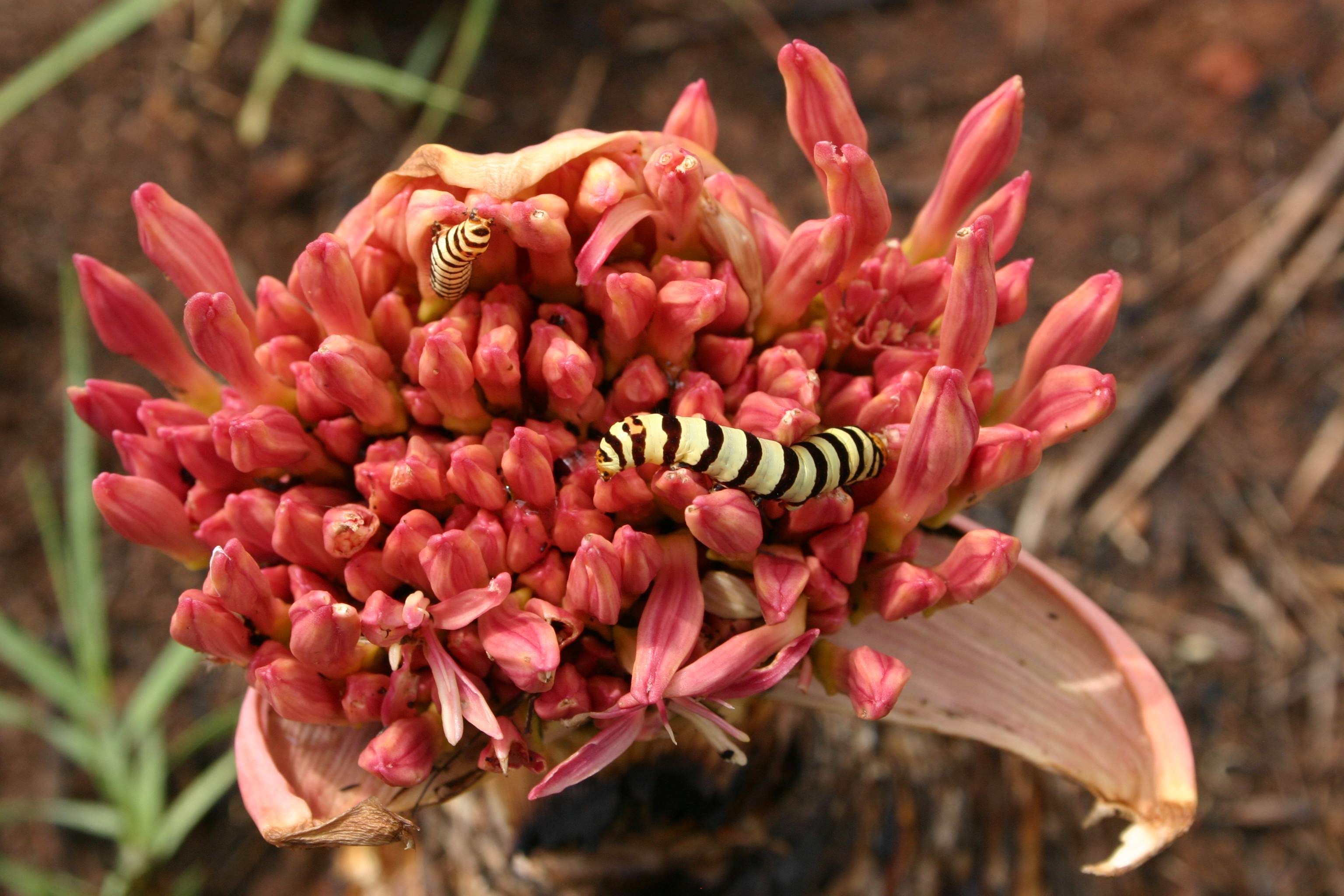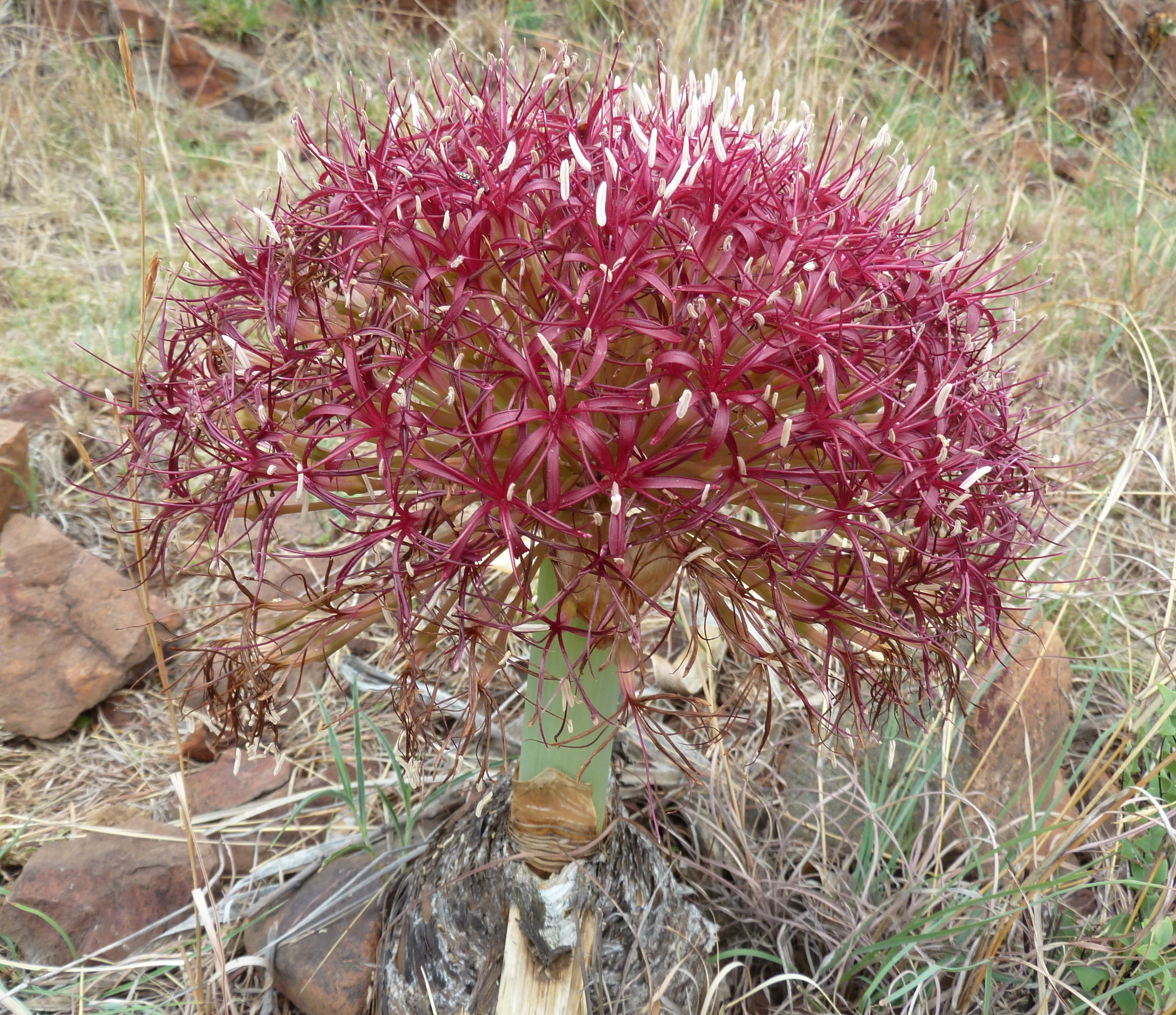|
Amaryllideae
Amaryllideae are a tribe of subfamily Amaryllidoideae (family Amaryllidaceae). They are herbaceous monocot perennial flowering plants with a predominantly Southern African distribution, with the exception of the pantropical genus ''Crinum''. They are generally treated as consisting of four subtribes. In addition to ''Crinum'', other genera include ''Amaryllis'', ''Boophone'' and ''Strumaria''. Taxonomy Phylogeny The placement of Amaryllideae within subfamily Amaryllidoideae is shown in the following cladogram: Subdivision There are four subtribes: * Amaryllidinae Pax * Boophoninae D.Müll.-Doblies & U.Müll.-Doblies * Crininae Baker * Strumariinae Traub ex D.Müll.-Doblies & U.Müll.-DobliesBot. Jahrb. 107: 18. 1985 emend Meerow & Snijman, 2001. These are phylogenetically related as follows: Amaryllidinae: Type. Monogeneric subtribe for genus ''Amaryllis''. Boophoninae: Monogeneric subtribe for genus ''Boophone''. Crininae: Three genera including ''Crin ... [...More Info...] [...Related Items...] OR: [Wikipedia] [Google] [Baidu] |
Amaryllidoideae
Amaryllidoideae (Amaryllidaceae ''s.s.'', amaryllids) is a subfamily of monocot flowering plants in the family Amaryllidaceae, order Asparagales. The most recent APG classification, APG III, takes a broad view of the Amaryllidaceae, which then has three subfamilies, one of which is Amaryllidoideae (the old family Amaryllidaceae), and the others are Allioideae (the old family Alliaceae) and Agapanthoideae (the old family Agapanthaceae). The subfamily consists of about seventy genera, with over eight hundred species, and a worldwide distribution. Description The Amaryllidoideae are herbaceous, perennial flowering plants, usually with bulbs (some are rhizomatous). Their fleshy leaves are arranged in two vertical columns, and their flowers are large. Most of them are bulbous geophytes and many have a long history of cultivation as ornamental plants. They are distinguished from the other two Amaryllidaceae subfamilies (Agapanthoideae and Allioideae) by their unique alkaloidal ... [...More Info...] [...Related Items...] OR: [Wikipedia] [Google] [Baidu] |
Amaryllidaceae
The Amaryllidaceae are a family of herbaceous, mainly perennial and bulbous (rarely rhizomatous) flowering plants in the monocot order Asparagales. The family takes its name from the genus ''Amaryllis'' and is commonly known as the amaryllis family. The leaves are usually linear, and the flowers are usually bisexual and symmetrical, arranged in umbels on the stem. The petals and sepals are undifferentiated as tepals, which may be fused at the base into a floral tube. Some also display a corona. Allyl sulfide compounds produce the characteristic odour of the onion subfamily (Allioideae). The family, which was originally created in 1805, now contains about 1600 species, divided into about 70–75 genera, 17 tribes and three subfamilies, the Agapanthoideae (agapanthus), Allioideae (onions and chives) and Amaryllidoideae (amaryllis, daffodils, snowdrops). Over time, it has seen much reorganisation and at various times was combined with the related Liliaceae. Since 2009, a very broa ... [...More Info...] [...Related Items...] OR: [Wikipedia] [Google] [Baidu] |
Crininae
Crininae is one of four subtribes within the tribe Amaryllideae ( subfamily Amaryllidoideae, family Amaryllidaceae), with a pantropical distribution (''Crinum'') and also sub-Saharan Africa. Description Leaves frequently show an intercalary meristem and are usually fringed with cartilaginous teeth. The leaf apices are also often truncate (cut off). The flowers may be actinomorphic to zygomorphic, with a perigone tube with free stamens. The fruit is indehiscent, irregular, and often rostellate (rosetted). The scape does not abscise (shed) during seed dispersal, with the exception of ''Ammocharis longifolia'' where it detaches at ground level. The seeds also lack an integument, but are endosperm-rich and partially chlorophyllous with cork-covering. Taxonomy Phylogeny Crininae are placed within Amaryllideae as follow: These are phylogenetically related as follows: Subdivision As circumscribed by Meerow ''et al.'' (2001), there were three genera (Species), althou ... [...More Info...] [...Related Items...] OR: [Wikipedia] [Google] [Baidu] |
Strumariinae
Strumariinae is one of four subtribes within the tribe Amaryllideae (subfamily Amaryllidoideae, family Amaryllidaceae), found in southern Africa. Description The leaves are often prostrate (on the ground). The flowers may be zygomorphic or actinomorphic, and may or may not have a perigone tube. The stamens are connate (fused) into a tube at their proximal end. However ''Strumaria'' has one whorl of the stamens fused to the style. The fruit is dehiscent with seeds that have a well-developed integument In biology, an integument is the tissue surrounding an organism's body or an organ within, such as skin, a husk, shell, germ or rind. Etymology The term is derived from ''integumentum'', which is Latin for "a covering". In a transferred, or ... that is chlorophyllous with a stomatose testa. Taxonomy Phylogeny Strumariinae are placed within Amaryllideae as follow: These are phylogenetically related as follows: Subdivision Strumariinae consists of six genera, ... [...More Info...] [...Related Items...] OR: [Wikipedia] [Google] [Baidu] |
Amaryllis
''Amaryllis'' () is the only genus in the subtribe Amaryllidinae (tribe Amaryllideae). It is a small genus of flowering bulbs, with two species. The better known of the two, ''Amaryllis belladonna'', is a native of the Western Cape region of South Africa, particularly the rocky southwest area between the Olifants River Valley and Knysna. For many years there was confusion among botanists over the generic names ''Amaryllis'' and ''Hippeastrum'', one result of which is that the common name "amaryllis" is mainly used for cultivars of the genus ''Hippeastrum'', widely sold in the winter months for their ability to bloom indoors. Plants of the genus ''Amaryllis'' are known as belladonna lily, Jersey lily, naked lady, amarillo, Easter lily in Southern Australia or, in South Africa, March lily due to its propensity to flower around March. This is one of numerous genera with the common name "lily" due to their flower shape and growth habit. However, they are only distantly related ... [...More Info...] [...Related Items...] OR: [Wikipedia] [Google] [Baidu] |
Amaryllidinae
''Amaryllis'' () is the only genus in the subtribe Amaryllidinae (tribe Amaryllideae). It is a small genus of flowering bulbs, with two species. The better known of the two, ''Amaryllis belladonna'', is a native of the Western Cape region of South Africa, particularly the rocky southwest area between the Olifants River Valley and Knysna. For many years there was confusion among botanists over the generic names ''Amaryllis'' and ''Hippeastrum'', one result of which is that the common name "amaryllis" is mainly used for cultivars of the genus ''Hippeastrum'', widely sold in the winter months for their ability to bloom indoors. Plants of the genus ''Amaryllis'' are known as belladonna lily, Jersey lily, naked lady, amarillo, Easter lily in Southern Australia or, in South Africa, March lily due to its propensity to flower around March. This is one of numerous genera with the common name "lily" due to their flower shape and growth habit. However, they are only distantly related t ... [...More Info...] [...Related Items...] OR: [Wikipedia] [Google] [Baidu] |
Boophoninae
''Boophone'' is a small genus of herbaceous, perennial and bulbous plants in the Amaryllis family (Amaryllidaceae, subfamily Amaryllidoideae.) It consists of two confirmed species distributed across South Africa to Kenya and Uganda. It is closely related to ''Crossyne'', a genus whose species have prostrate leaves. They are drought tolerant but not cold-hardy, and are very poisonous to livestock. Taxonomy ''Boophone'' is the single genus in subtribe Boophoninae, in the Amaryllideae tribe. Phylogeny Boophoninae are placed within Amaryllideae as follows, based on their phylogenetic relationship: Species The list of ''Boophone'' species, with their complete scientific name, authority, and geographic distribution is given below.Royal Botanical Gardens, KewWorld Checklist of Monocotyledons: ''Boophone '' Accessed May 16, 2009. Etymology William Herbert wrote the name of this genus with three different orthographies: "Boophane" in 1821; "Buphane" and "Buphone" in 1825 ... [...More Info...] [...Related Items...] OR: [Wikipedia] [Google] [Baidu] |
Boophone
''Boophone'' is a small genus of herbaceous, perennial and bulbous plants in the Amaryllis family (Amaryllidaceae, subfamily Amaryllidoideae.) It consists of two confirmed species distributed across South Africa to Kenya and Uganda. It is closely related to ''Crossyne'', a genus whose species have prostrate leaves. They are drought tolerant but not cold-hardy, and are very poisonous to livestock. Taxonomy ''Boophone'' is the single genus in subtribe Boophoninae, in the Amaryllideae tribe. Phylogeny Boophoninae are placed within Amaryllideae as follows, based on their phylogenetic relationship: Species The list of ''Boophone'' species, with their complete scientific name, authority, and geographic distribution is given below.Royal Botanical Gardens, KewWorld Checklist of Monocotyledons: ''Boophone '' Accessed May 16, 2009. Etymology William Herbert wrote the name of this genus with three different orthographies: "Boophane" in 1821; "Buphane" and "Buphone" in 182 ... [...More Info...] [...Related Items...] OR: [Wikipedia] [Google] [Baidu] |
Eustephieae
Eustephieae is a tribe (in the family Amaryllidaceae, subfamily Amaryllidoideae), where it forms part of the Andean clade, one of two American clades. Taxonomy Phylogeny This tribe was resurrected from the Stenomesseae in 1995 by Meerow. The placement of Eustephieae within subfamily Amaryllidoideae is shown in the following cladogram, where this tribe is shown as a sister group to the remainder of the tetraploid Andean clade. Subdivision Four genera: * '' Eustephia'' * '' Chlidanthus'' * '' Hieronymiella'' * ''Pyrolirion ''Pyrolirion'', commonly known as fire lilies or flame lilies, is a small genus of herbaceous, bulb-forming South American plants in the Amaryllis family, native to Chile, Peru, and Bolivia. Description ''Pyrolirion'' have thin linear leaves ...'' Distribution The Eustephieae for the southern limit of the Andean clade. They are found in Peru in the southern Andes, and the northern Andes of Argentina, Bolivia and Chile. This is distinct ... [...More Info...] [...Related Items...] OR: [Wikipedia] [Google] [Baidu] |
Lycorideae
Lycorideae are a small tribe of subfamily Amaryllidoideae (family Amaryllidaceae). They are herbaceous monocot perennial flowering plants endemic to Asia, and consisting of two genera including the type genus In biological taxonomy, the type genus is the genus which defines a biological family and the root of the family name. Zoological nomenclature According to the International Code of Zoological Nomenclature, "The name-bearing type of a nominal ..., '' Lycoris''. Taxonomy Phylogeny The placement of Lycorideae within subfamily Amaryllidoideae is shown in the following cladogram: Subdivision There are two genera: * '' Lycoris'' * '' Ungernia'' References Bibliography * * * External links * * {{Taxonbar, from=Q9025725 Amaryllidoideae Asparagales tribes ... [...More Info...] [...Related Items...] OR: [Wikipedia] [Google] [Baidu] |
Cyrtantheae
''Cyrtanthus'' is a genus of perennial, herbaceous and bulbous plants in the family Amaryllidaceae, subfamily Amaryllidoideae. Taxonomy ''Cyrtanthus'' is the sole genus in the African tribe Cyrtantheae. Phylogeny The placement of Cyrtantheae within subfamily Amaryllidoideae is shown in the following cladogram: Subdivision There are over 50 recognized species, all native to central and southern Africa Africa is the world's second-largest and second-most populous continent, after Asia in both cases. At about 30.3 million km2 (11.7 million square miles) including adjacent islands, it covers 6% of Earth's total surface area .... References Bibliography * External links Images of several species of ''Cyrtanthus'' from Pacific Bulb Society {{Taxonbar, from=Q310372, from2=Q10464992, emonocot=303795 Amaryllidaceae genera Amaryllidoideae Flora of Africa ... [...More Info...] [...Related Items...] OR: [Wikipedia] [Google] [Baidu] |
Haemantheae
Haemantheae are a tribe of subfamily Amaryllidoideae (family Amaryllidaceae). They are herbaceous monocot perennial flowering plants with a predominantly African distribution. Three subtribes are proposed and six genera including the type genus, ''Haemanthus'', are included. They are characterised by the presence of baccate (berry) fruit. Taxonomy Phylogeny The placement of Haemantheae within subfamily Amaryllidoideae is shown in the following cladogram: Subdivision There are three subtribes, with six genera * Cliviinae D.Müll.-Doblies & U.Müll.-Doblies * Haemanthinae Pax * Gethyllidinae Meerow The subtribes are related as follows: Cliviinae: Two genera - ''Clivia'', ''Cryptostephanus'' Haemanthinae: Type - two genera, ''Haemanthus'', ''Scadoxus'' Gethyllidinae: Two genera - ''Apodolirion ''Apodolirion'' is a genus of herbaceous, perennial and bulbous plants in the Amaryllis family ( Amaryllidaceae, subfamily Amaryllidoideae). It consists of 6 species d ... [...More Info...] [...Related Items...] OR: [Wikipedia] [Google] [Baidu] |





